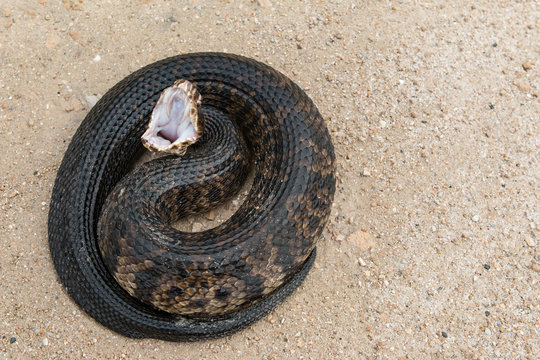ANIMAL: Florida Cottonmouth Agkistrodon conanti Type of Animal: Viper Habitat: Freshwater/brackish water: swamps, marshes, ditches, ponds, edges/shores of ponds/lakes/streams, streams, rivers, creeks, lakes, wetlands, coastal plains, floodplains, wet fields, rice fields, riparian zones, ponds/streams in offshore keys, brackish tidal estuaries, bayheads, sloughs, canals, & bayous. Sometimes found in saltwater areas in marshes & offshore keys. Hibernate/bask in land areas in upland areas, fields, agricultural areas near water, pine forests/woodlands, palmetto thickets, pine-palmetto forest, pine flatwoods, deciduous dune forest, dunes, beaches, riparian forest, & prairies. Location(s): S Georgia, SE Alabama, & Florida Appearance: Very similar appearance to closely related Northern Cottonmouth, lighter face markings than Northern Cottonmouth, 2 dark vertical lines on snout, dark snake w/ heavy body, younger snakes lighter in color w/ brighter tail tips (tail tips fade w/ age), whitish belly, named for white mouth, coloration ranges from dark brown to jet black to olive green, Food/Diet: Fish up to size of catfish, bass, & pike, amphibians, young crocodilians, turtles, young tortoises, lizards, other snakes (including smaller members of own species & other venomous species), birds up to size of great egrets (great egrets sometimes eat the snakes), mammals up to size of rabbits & muskrats, carrion, eggs, snails, as well as caterpillars, cicadas, & other insects Status in Wild: Stable Conservation: Breeding in zoos & reptile centers Lifestyle: Solitary Additional Info: Called: Male Female Young: Snakelet Group: Solitary Weight: Male: 4 lbs Female: 3 lbs Gestation: 3-4 months Life Span: 20 years Body Length: Male: 4-5 ft Female: 3 ft Young: 1 ft Tail Length: 0.5-1 ft, same for both sexes Main predators of adults are crocodilians, bobcats, coyotes, foxes, raptors, bears, snapping turtles, dogs, cats, raccoons, opossums, feral pigs, large wading birds, cranes, shrikes, larger cottonmouths, kingsnakes, black racers, black ratsnakes, & largemouth bass (the latter 5 sometimes being eaten by cottonmouth in fights to death). Young preyed on by longnose gar & smaller egrets/herons. Gives birth to 1-20 live young every 2-3 years. These snakes also known as water moccasins. These snakes most active at night. Juveniles use tail tips to lure prey. Sometimes hybridize w/ closely related Northern Cottonmouth. These snakes are excellent swimmers. Fun Fact(s): Contrary to popular belief, these snakes are well capable of biting underwater. These snakes not as aggressive as people say & retreat if given chance. They don’t chase people. Get name from habit of opening white mouth when threatened. Many nonvenomous water snakes mistaken for them & killed. They have hemotoxic venom.
